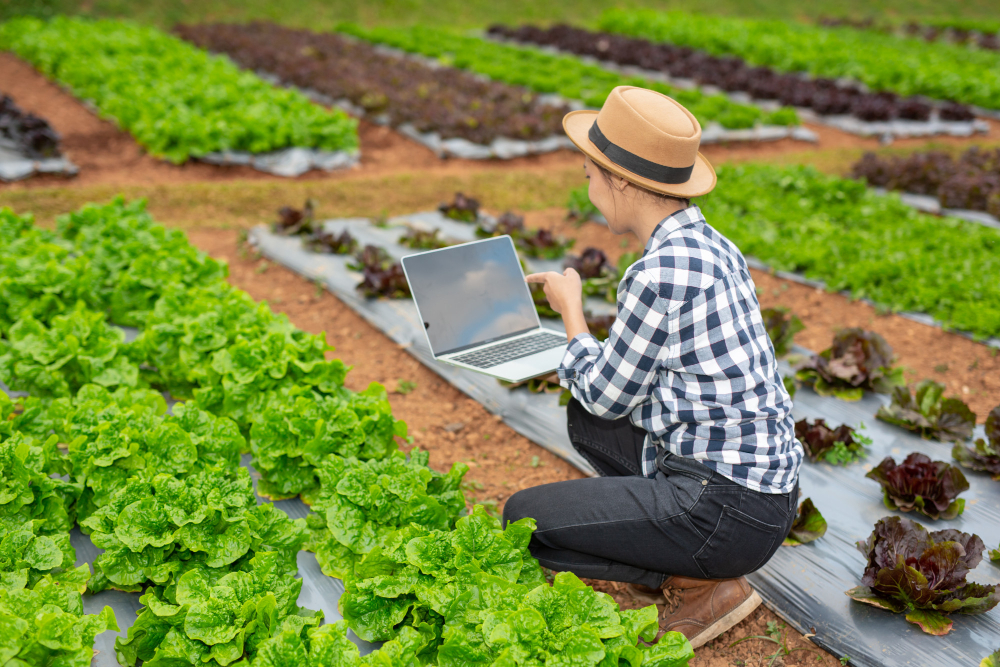Introduction
Agriculture is at the foundation of our civilization. With technological advancement, modernized practices have deviated significantly from previous methods. AgTech (agriculture technology) has enabled revolution in this industry; and this blog post delves deep into all its manifestations from precision farming to advanced robotics that is revolutionizing agriculture today and its benefits, challenges, and long-term possibilities.
The Evolution of Agriculture Technology
Agriculture Technologevolution The advancement of agricultural technology is intrinsically tied to human society itself. From ancient irrigation systems and mechanized agriculture during the Industrial Revolution to today’s digital era bringing with it technological innovations that aim to redefine farming once more.
Precision Farming: Cultivating with Accuracy
Precision Farming: Cultivating with Accuracy Precision agriculture stands as one of the cornerstones of modern AgTech. Utilizing satellite imagery, GPS technology and sophisticated sensors, precision agriculture enables farmers to monitor and manage their fields with unprecedented accuracy, not only increasing crop yields but also optimizing resources such as water use, fertilizers and pesticides to the greatest effect while decreasing resource waste.
Smart Irrigation Systems: Nurturing Crops Intelligently
Water shortage is an international concern, making smart irrigation systems a critical element of AgTech. IoT devices linked with soil moisture sensors and weather forecasting allow farmers to deliver just the right amount of water at exactly the right time, conserving water usage as well as avoiding over-irrigation which degrades soil quality.
Agricultural Drones: Taking to the Skies for Farming
Agriculture no longer faces limits. Drones equipped with cameras and sensors fly above fields collecting real-time data about crop health, pest infestation and growth patterns for farmers’ analysis – so they can proactively address issues early, take targeted action where needed, make informed decisions to guarantee an abundant harvest.
Vertical Farming: Agriculture’s Ascent Indoors
Agriculture’s Rise Indoors With urbanization rising at such a staggering rate, creative solutions such as vertical farming have emerged to ease our planet’s expanding urban sprawl. By layering crops within controlled environments in this way, this technique provides year-round production while decreasing land usage and pesticide needs while creating year-round production without using harmful pesticides or harsh chemical sprays. Advanced LED lighting simulates natural sunlight to stimulate photosynthesis for further plant development and promote plant health.
Biotechnology and GMOs: A Controversial Frontier
Genetic engineering of crops can be an innovative yet controversial solution to food security concerns by adding traits like drought resistance or insect resistance, giving scientists more options when working under adverse conditions. While you could produce crops through genetic engineering techniques, ethical considerations as well as potential environmental ramifications must be carefully considered when producing GMOs for commercialization purposes.
Robotics in Agriculture: Automating the Fields
Robots have taken over global agriculture, filling labor shortages while streamlining operations. Planting, weeding and harvesting robots work around-the-clock to increase efficiency while decreasing manual labor needs; when combined with artificial intelligence capabilities they become indispensable allies of farmers worldwide.
Benefits and Impact of agriculture technology
Technology integration has brought forth new possibilities and changed the face of farming forever; its effects are wide ranging indeed.
1. Increased Crop Yields and Quality:
AgTech maximizes plant yields and quality by optimizing every stage from planting through harvest, using precision farming techniques that use every inch of land efficiently while the smart watering system delivers just enough liquid nutrients directly to plants for enhanced plant health and yields. Farmers are thus able to produce more food while simultaneously conserving resources – contributing towards global food security in this way.
2. Resource Efficiency and Sustainability:
A key challenge facing agriculture today is overusing chemicals that threaten ecosystems and human health, but AgTech allows farmers to implement comprehensive pest management strategies through real-time monitoring and intervention utilizing natural enemies, precise pesticide applications, crop rotation practices and crop rotation resulting in safer and more eco-friendly agricultural practices.
3. Reduced Chemical Usage:
One of agriculture’s greatest challenges lies in its excessive chemical usage, which poses risks to both ecosystems and human health. With real-time monitoring and intervention from AgTech solutions providers, farmers are empowered to employ integrated pest management strategies such as using natural predators such as birds and spiders; targeted application of specific pesticide products; crop rotation strategies to create more environmentally responsible practices, thus making for safer farming practices with longer term sustainability benefits.
4. Economic Growth and Job Creation:
Technology integration doesn’t just improve agricultural productivity – it also promotes economic development. AgTech is creating an upward ripple across several industries: software developers create agricultural apps; engineers design drones and robots for agriculture purposes; data scientists conduct analyses on complex data sets… This networked innovation system brings with it new job opportunities as well as economic prosperity for everyone involved.
5. Climate Change Resilience:
Agriculture’s relationship to climate conditions has always been close. Agtech gives farmers tools they need to adapt to ever-evolving weather patterns, including drones equipped with sensors that detect early signs of drought stress or disease outbreak. Indoor farming offers protection from unpredictable weather.
6. Bridging the Rural-Urban Divide:
AgTech can bridge the divide between rural and urban communities. As technology pervades even remote regions, farmers now have access to essential information and services that have transformed their lives – market insights, weather forecasts and best practices that enable more informed decision making are just some of these benefits of AgTech integration into society.
7. Customization and Personalization:
Modern consumers increasingly demand transparency when it comes to food sources, AgTech makes this possible by tracking how food moves from farm to fork and through to their plates. Consumers can scan QR codes associated with products to gain more information regarding origin, farming methods and ethical practices; ultimately creating trust with and customer loyalty among their food supply.
Challenges and Considerations
But there can be hurdles on the journey towards an AgTech-driven future, too. High acquisition costs make it hard for small farmers to access advanced technologies – exacerbating inequalities further. Furthermore, our growing dependence on tech has raised privacy and cybersecurity issues; striking an appropriate balance between innovation and ethical and fair practices must therefore remain top priorities.
Future Trends in AgTech
AgTech continues to expand in scope in the future, as artificial intelligence becomes an even more potent tool for predictive analytics, disease detection and precision agriculture. Blockchain technology offers consumers transparency with regard to supply chains assuring consumer trust in food’s origin and quality while climate-friendly agriculture will become the focus of innovative solutions designed to mitigate climate change impacts.
Conclusion
Integrating technology into agriculture represents more than efficiency gains – it represents a radical transformation in how food production, sustainability and economic development is approached. By creating an ecosystem which benefits farmers, consumers and the planet. With technology’s progressing pace and increasing capabilities in farming, its reach will become ever wider, creating more resilient, productive, sustainable future for us all.


